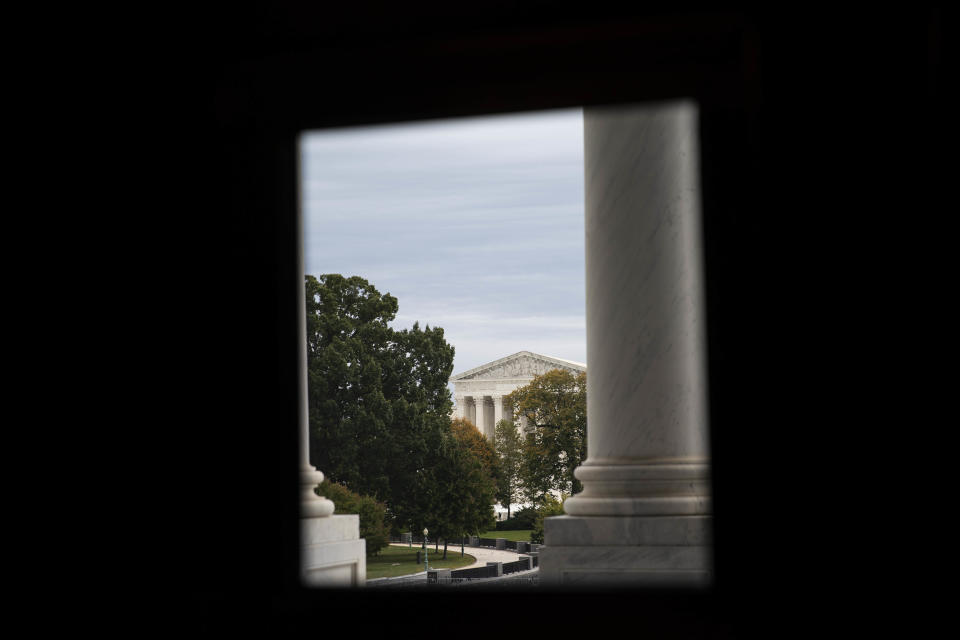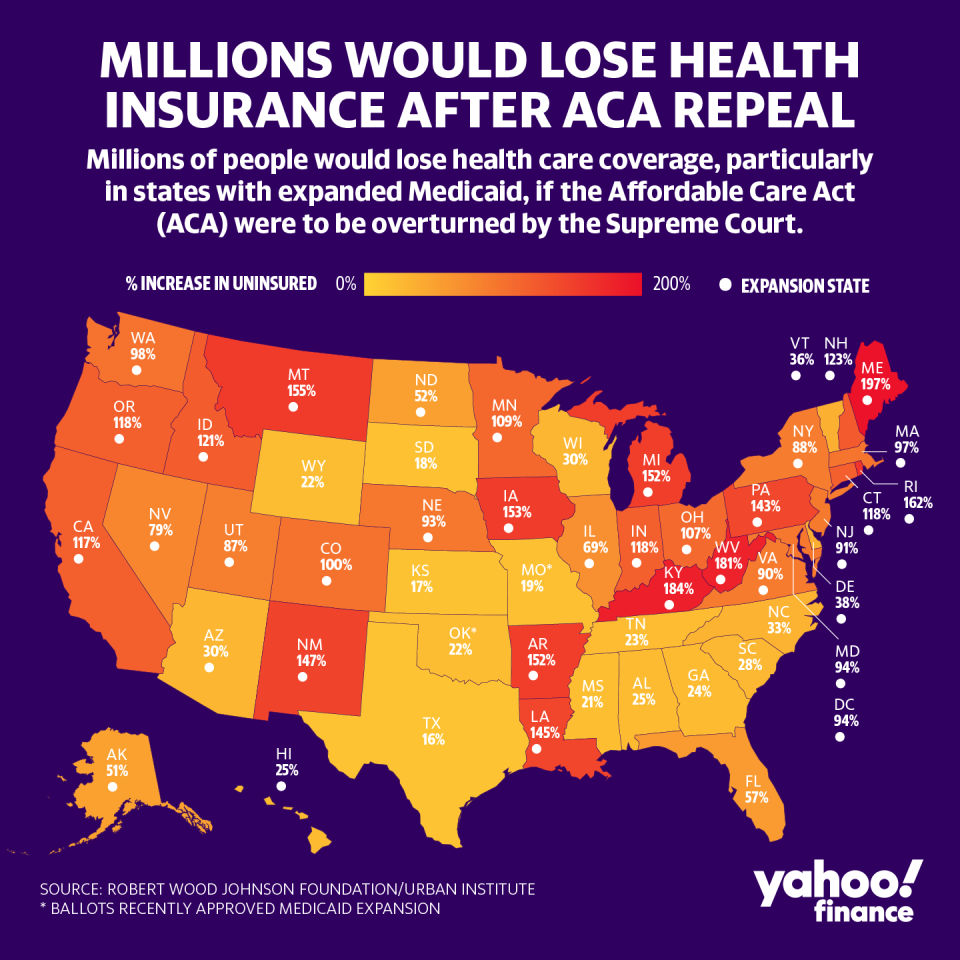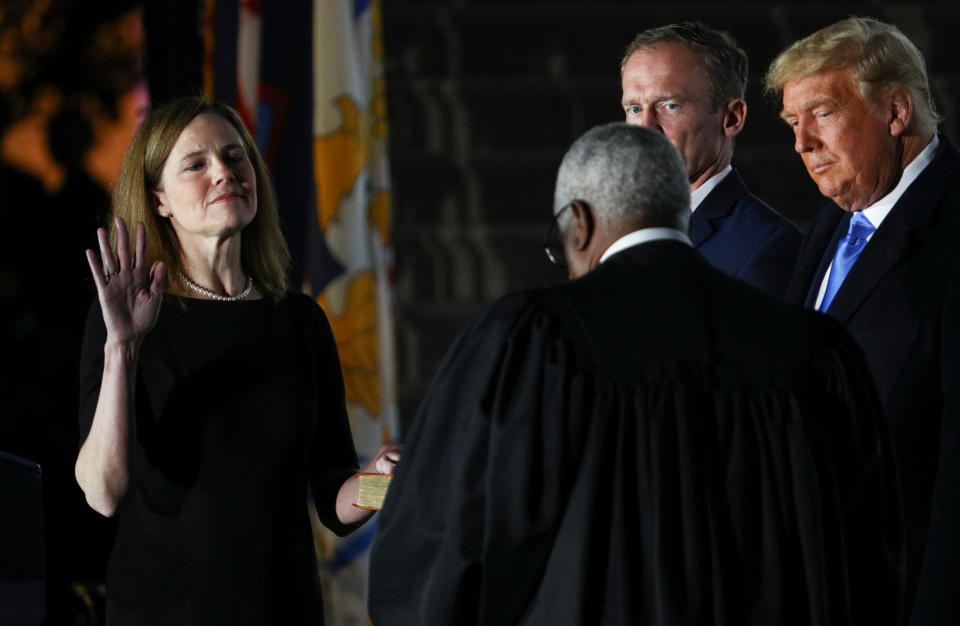Supreme Court's Obamacare arguments: What the justices are set to decide
On Tuesday, the nine Supreme Court justices will gather for one of the most closely watched high court cases in years, a challenge to the Affordable Care Act (ACA), also known as Obamacare.
The fate of the ACA will be on the docket as justices — including newly confirmed Amy Coney Barrett — will hear arguments about the constitutionality of the law’s so-called individual mandate that Americans buy health insurance.
The case had already been highly anticipated, but the death of Justice Ruth Bader Ginsburg raised the stakes even higher as outgoing President Donald Trump and other Republicans push to take down the law while Democrats hope former President Barack Obama’s 2010 signature achievement survives yet another challenge.
“I think it is pretty obvious that this puts the ACA at risk,” Cynthia Cox, a vice president at the Kaiser Family Foundation, told Yahoo Finance in September, before Barrett’s confirmation. She added that “the Affordable Care Act is much more at risk of being overturned than it would have been with [Ginsburg] still on the court.”

During an Oct. 30 appearance on Yahoo Finance, the CEO of BondCliq, Chris White, noted the business implications of the case. A ruling to take out Obamacare “would completely change the outlook for insurers, because obviously, they could create a community of healthy people that they insure and deny insurance to other folks,” White noted.
But like almost everything the court considers, the case is deeply complex and few are confidently predicting how all this will end up changing American’s health care system. There “are permutations that people don't take into account,” said Thomas Miller, a resident fellow at the American Enterprise Institute in September, before Barrett’s confirmation. “A lot of things are out on the table.”
Can Obamacare survive without the individual mandate?
The case — which consolidates two cases, Texas v. California and California v. Texas — will examine three major questions. First, the justices will decide whether a coalition of 18 states, including Texas, and two individuals that brought the suit, have a legal right to sue known as “standing” — meaning they suffered an injury that can be redressed in court.
If the court finds that the law’s challengers have standing to sue, it will decide whether the individual mandate is constitutional and whether the ACA can survive without the mandate.
The law has withstood two major challenges before the Supreme Court already. Back in 2012, the justices upheld the individual mandate in a case called National Federation of Independent Business v. Sebelius. The mandate was upheld — in a decision written by Chief Justice John Roberts — because it was seen as a tax. Then, in 2017, Trump’s $1.5 trillion Tax Cuts and Jobs Act tax effectively eliminated the mandate by lowering the penalty to zero.

This was an opening for some Republican states, led by Texas, to open yet another legal fight to declare the mandate unconstitutional. Ken Paxton, Attorney General of Texas, has spearheaded the effort to take down the law and told Yahoo Finance during an appearance earlier this year that "what we hope to offer is more choice, more opportunity for the consumer."
In 2019, a federal appeals court in New Orleans ruled against the mandate but left open the key question of how much of the ACA must fall along with the mandate.
“The next question is, there is no individual mandate, if that's not constitutional anymore, then can you have the rest of the law without the mandate in place,” Cox explained, in reference to a legal theory known as severability.
If the mandate can be severed from the rest of the law, that would allow the other provisions to remain intact.
What striking down the mandate might mean
Striking down all or part of the law could create a “huge mess,” said Christen Linke Young, a health policy fellow at the Brookings Institution, in an interview in September. There are more than 11 million people who receive health care coverage through the Obamacare marketplace, according to an April 1 open enrollment report.
“Either way, the consequences are pretty severe,” she added. Even “striking down only the guaranteed issue and community rating components of the ACA would throw individual insurance markets into total chaos, and just be completely unworkable in the middle of a pandemic.”
Another factor is the two years that have passed since Republicans effectively eliminated the mandate, and in that time, Obamacare has continued to function.

“So we actually know now whether the rest of the ACA can work or not work without the individual mandate penalty,” Cox said. “The fact is that it can work and this, maybe, isn't what most experts of the ACA would have thought.”
The many factors at play lead the American Enterprise Institute’s Miller — a long-time critic of Obamacare — to be skeptical that any decision will be as far reaching as either side hopes or fears.
Speaking to Yahoo Finance in September, he said the likely outcome in the case “has been vastly overstated.” When asked to lay out the different scenarios for how this plays out, he jokingly said: “I can narrow it down to about 20 or so,” citing everything from a tie that doesn’t change precedent to the argument date being moved to a John Roberts decision that few see coming which, after all, has happened before.
Barrett’s confirmation eliminates the possibility of a tie, unless another justice recuses himself or herself. In 2017, she wrote critically of the chief justice’s majority decision to uphold the statute.
“... Chief Justice Roberts pushed the Affordable Care Act beyond its plausible meaning to save the statute,” Barrett wrote in a paper for Notre Dame Law School. “He construed the penalty imposed on those without health insurance as a tax, which permitted him to sustain the statute as a valid exercise of the taxing power; had he treated the payment as the statute did—as a penalty—he would have had to invalidate the statute as lying beyond Congress’s commerce power.”

The scope of the Supreme Court’s decision could be limited in another way: if Democrats are able to pass legislation to reinstate the individual mandate which could address the underlying question in this case and, possibly, render the whole matter moot. Control of the Senate remains undecided with two runoff races in Georgia set to decide control of the chamber in January.
With the Republican success in getting another like-minded justice on the court before Nov. 10, Roberts could no longer be the swing vote with five justices inclined to repeal the law.
One last thing to remember: While the arguments are happening this year, a final ruling is not expected until 2021.
An earlier version of this post was published on Sept. 22, 2020.
Adriana Belmonte is a reporter and editor covering politics and health care policy for Yahoo Finance. Ben Werschkul is the DC producer for Yahoo Finance.
READ MORE:
Follow Yahoo Finance on Twitter, Facebook, Instagram, Flipboard, LinkedIn, YouTube, and reddit.
